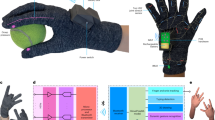Abstract
A novel human machine interface is presented that ‘self-adapts’ to accommodate for changes in position between an operator and a non-contact sensor. Zero force sensing has been especially suitable for people with small amounts of movement force, making switch operation difficult or impossible. A common issue with existing switches concerned maintaining a workable operating position for a user. Testing of new “auto adapting” sensors demonstrated the viability of the approach and optical sensors provided a workable solution, but problems were encountered in strong light. Further work addressed this problem.
Access this chapter
Tax calculation will be finalised at checkout
Purchases are for personal use only
Similar content being viewed by others
References
Krops, L.A., Hols, D.H., Folkertsma, N., Dijkstra, P.U., Geertzen, J.H., Dekker, R.: Requirements on a community-based intervention for stimulating physical activity in physically disabled people: a focus group study amongst experts. Disab Rehabil 40(20), 2400–2407 (2018)
Bos, I., Wynia, K., Almansa, J., Drost, G., Kremer, B., Kuks, J.: The prevalence and severity of disease-related disabilities and their impact on quality of life in neuromuscular diseases. Disabil Rehabil 41(14), 1676–1681 (2019)
Sanders, D., Langner, M., Tewkesbury, G.: Improving wheelchair-driving using a sensor system to control wheelchair-veer and variable-switches as an alternative to digital-switches or joysticks. Ind. Rob.: Int. J. 32(2), 157–167 (2010)
Sanders, D., Haddad, M., Tewkesbury, G., Thabet, G., Omoarebun, P., Barker, T.: Simple expert system for intelligent control and HCI for a wheelchair fitted with ultrasonic sensors. In: Proceedings of the 2020 IEEE 10th International Conference on Intelligent Systems-IS (Varna), pp 211–216 (2020)
Sanders, D., Gegov, A.: Using artificial intelligence to share control of a powered-wheelchair between a wheelchair user and an intelligent sensor system EPSRC Project, 2019–2022 (2018)
Langner, M.: Effort reduction and collision avoidance for powered wheelchairs: SCAD assistive mobility system. Ph.D. dissertation, School of Mech. Eng., University of Portsmouth, UK (2012)
Sanders, D., Tewkesbury, G., Haddad, M., Huang, Y., Vatchova, B.: Intelligent control of a semi-autonomous assistive vehicle. In: Arai, K. (ed.) IntelliSys 2021. LNNS, vol. 294, pp. 613–621. Springer, Cham (2022). https://doi.org/10.1007/978-3-030-82193-7_40
Sanders, D., Haddad, M., Tewkesbury, G., Bausch, N., Rogers, I., Huang, Y.: Analysis of reaction times and time-delays introduced into an intelligent HCI for a smart wheelchair In: Proceedings of the 2020 IEEE 10th International Conference on Intelligent Systems-IS (Varna), pp 217–222 (2020)
Sanders, D., et al.: Introducing time-delays to analyze driver reaction times when using a powered wheelchair. In: Arai, K., Kapoor, S., Bhatia, R., et al. (eds.) Intelligent Systems and Applications. Advances in Intelligent Systems and Computing, vol. 1252, pp. 559–570. Springer, Cham (2021). https://doi.org/10.1007/978-3-030-55190-2_41
Sanders, D., Haddad, M., Tewkesbury, G., Gegov, A., Adda, M.: Are human drivers a liability or an asset? In: Arai, K. (ed.) Intelligent Systems and Applications. Lecture Notes in Networks and Systems, vol. 294, pp. 805–816. Springer, Cham (2022). https://doi.org/10.1007/978-3-030-82193-7_54
Author information
Authors and Affiliations
Corresponding author
Editor information
Editors and Affiliations
Rights and permissions
Copyright information
© 2023 The Author(s), under exclusive license to Springer Nature Switzerland AG
About this paper
Cite this paper
Langner, M., Sanders, D., Tewkesbury, G., Zhou, S., Haddad, M. (2023). Human Machine Interaction Using Zero Force Sensing Switches Incorporating Self-adaptation. In: Wen, S., Yang, C. (eds) Biomedical and Computational Biology. BECB 2022. Lecture Notes in Computer Science(), vol 13637. Springer, Cham. https://doi.org/10.1007/978-3-031-25191-7_20
Download citation
DOI: https://doi.org/10.1007/978-3-031-25191-7_20
Published:
Publisher Name: Springer, Cham
Print ISBN: 978-3-031-25190-0
Online ISBN: 978-3-031-25191-7
eBook Packages: Computer ScienceComputer Science (R0)




